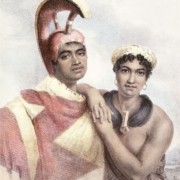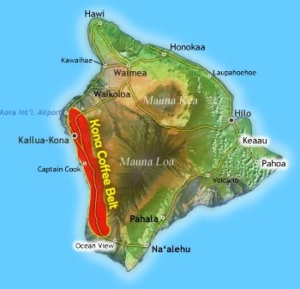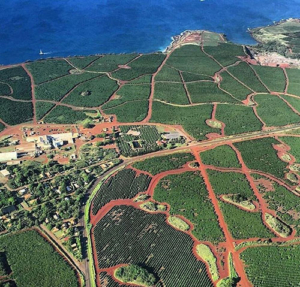Kona vs Kauai Coffee: A History of Coffee in Hawai’i
Among coffee aficionados the Kona coffee name has become ubiquitous, especially when talking about high quality beans. But how did the Kona region of the Big Island become associated with coffee cultivation, and how did Kauai come to have the largest coffee plantation in the United States? Read on to delve into the history of coffee in Hawai’i over the last few centuries.
Coffee’s Beginnings in Hawai’i: A Global Confluence of Interests
The arrival of coffee on the islands can be traced back to King Kamehameha I and his Spanish confidant Don Francisco de Paula y Marin. Don Francisco was an avid horticulturist, and is credited with introducing grapes, pineapples, mangos, cotton and oranges to the islands, along with the very first coffee seedlings on Oahu in 1813. These seedlings did not flourish, let alone survive, however they introduced coffee as an intriguing new prospect for Hawaiian agriculture.

Governor Boki (left)
The next instance of coffee cultivation in Hawai’i came from Royal Governor Boki, again on Oahu. Arriving back on Oahu from a diplomatic mission to England, Governor Boki’s ship also carried Arabica coffee saplings from Brazil, which were planted in land allotments around Honolulu in 1825. These early coffee farms eventually failed as well, but not before coffee had already begun to spread to the other islands.
A Seed is Planted: Kona Coffee is Created
As coffee saplings began to make their way around the Hawaiian islands, the missionary Samuel Ruggles planted the first saplings in the Kona district in 1828. Unlike the earlier Brazilian Arabica coffee trees, however, Ruggles planted Guatemalan Typica coffee saplings. These initial saplings would eventually lead to the establishment of Kona as a coffee powerhouse, and the creation of the unique Kona Typica coffee tree, though not without several more economic and natural disasters. The Great Māhele of 1848 allowed private land ownership for the first time in Hawaii’s history, which greatly expedited the creation of large scale coffee farming operations. Sugarcane plantations were also on the rise at this time, however, which hindered coffee’s rise to economic importance. In particular, Hawaii’s annexation by the United States in 1898 meant sugar tariffs were dropped, and the industry exploded in profitability. Coffee plantations across the islands were ripped up in favor of planting more sugarcane, except in Kona on the Big Island.
Why, then, did Kona remain a coffee-focused zone? The answer, surprisingly, is the very same

A map showing the Kona coffee region
sugarcane industry that hindered coffee production across the other islands. For starters, sugarcane didn’t grow very well in the sloping hills of the Kona region, nor did it like the acidic, nutrient dense volcanic soil. This meant that while most farmers across the islands were turning to the more profitable sugarcane, farmers in the Kona region were forced to double down on their coffee farms. Additionally, the sugarcane industry brought in an incredible amount of immigrant laborers, primarily from Japan. As these Japanese workers finished out their backbreaking contracts on the sugarcane plantations, they would lease small plots of land in Kona where they would instead begin growing coffee. Not only was the labor easier, but this allowed for the beginnings of financial independence for the workers as well.
Over the next 80 years, through two world wars and the Great Depression, Kona remained the primary coffee production zone in Hawai’i, which allowed it to develop a reputation as a sought-after, quality coffee.
From Ruins to Riches: Kauai Coffee Rises from the Destruction of Hurricane Iwa
In 1982, Hurricane Iwa slammed into Kauai and devastated the sugarcane crops of the Mcbryde Sugar Company. Facing financial ruin and with no crop to speak of, the Mcbryde Co. shifted gears completely and decided to replant, not with sugarcane, but with coffee! This led to the creation of the

Aerial view of the Kauai Coffee Plantation
Kauai Coffee Company, which today spans over 3,000 acres and 4 million coffee trees. Disaster struck again in 1992, with Hurricane Iniki again devastating crops of coffee trees instead of sugarcane, but by 1996 the Kauai Coffee Co. was out producing the entire Kona region on Big Island.
The Kauai Coffee Company is currently the largest coffee grower in the United States, responsible for over half of all coffee grown in the US, and all aspects of production from growing, harvesting, processing, roasting, and packaging happen on site. Although Kauai coffee doesn’t boast the world-renowned Kona coffee name, many coffee lovers prefer the Kauai coffee for its smoother and more mellow taste. This is due to the lower elevation growth in Kauai; coffee grown at higher elevations has a bolder, more acidic flavor due to the harder coffee beans, whereas coffee grown at lower elevations, such as that of Kauai, produces a less acidic, lighter coffee with a broader range of flavors.
The next time you’re on Kauai, we highly recommend stopping by the Kauai Coffee Plantation for a tour and hot cup of Kauai coffee! Located a short drive away from any of our South Shore properties in Kalaheo, Kauai Coffee Co. is a great way to learn about sustainable agriculture on the islands, as well as the role coffee plays in the local economy.
For more history on the origins of coffee in Hawai’i, specifically Kona coffee, check out this article.
For an interesting read on coffee legislation, and smaller roasters taking advantage of the Kona name, check out this Beat of Hawai’i article.
